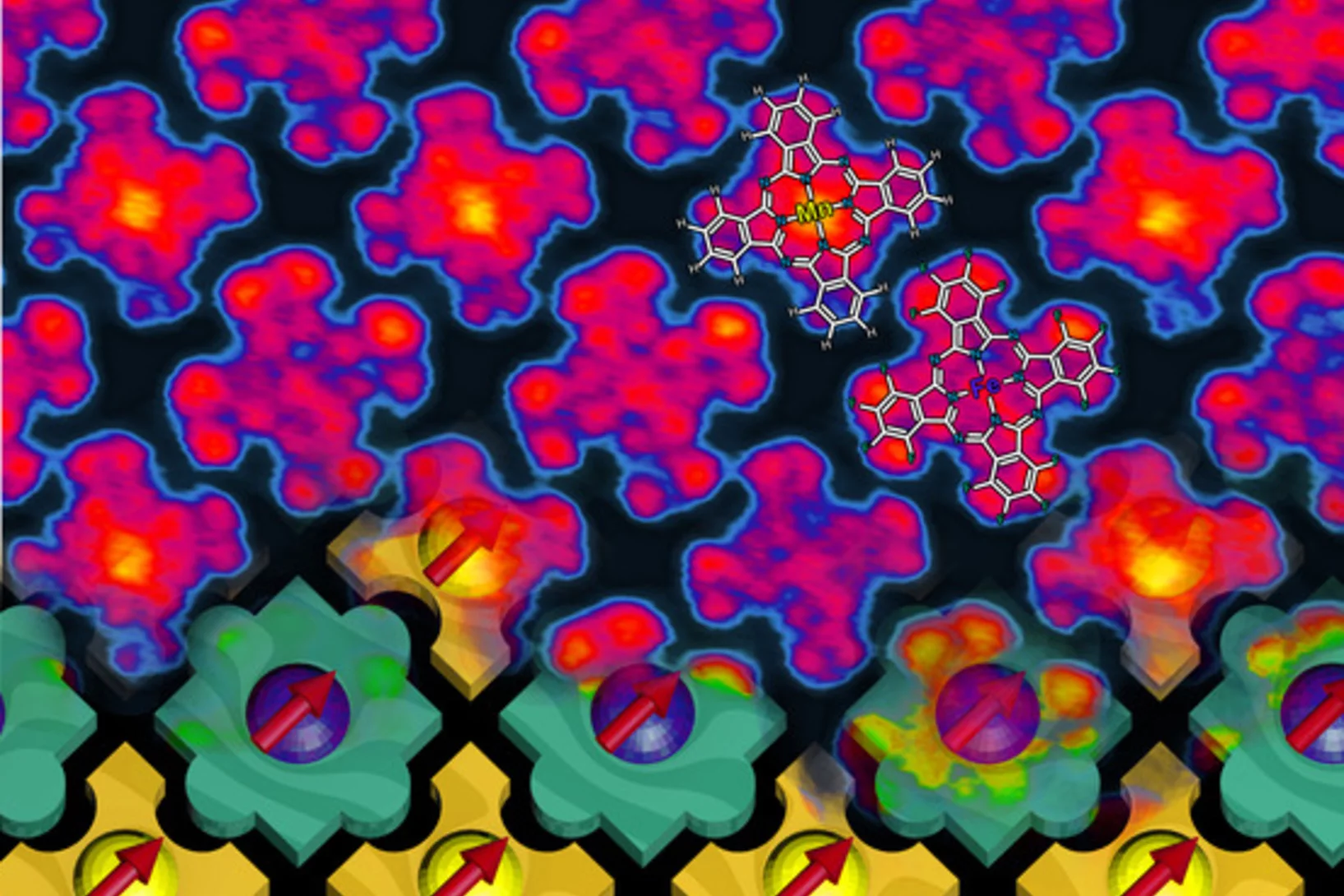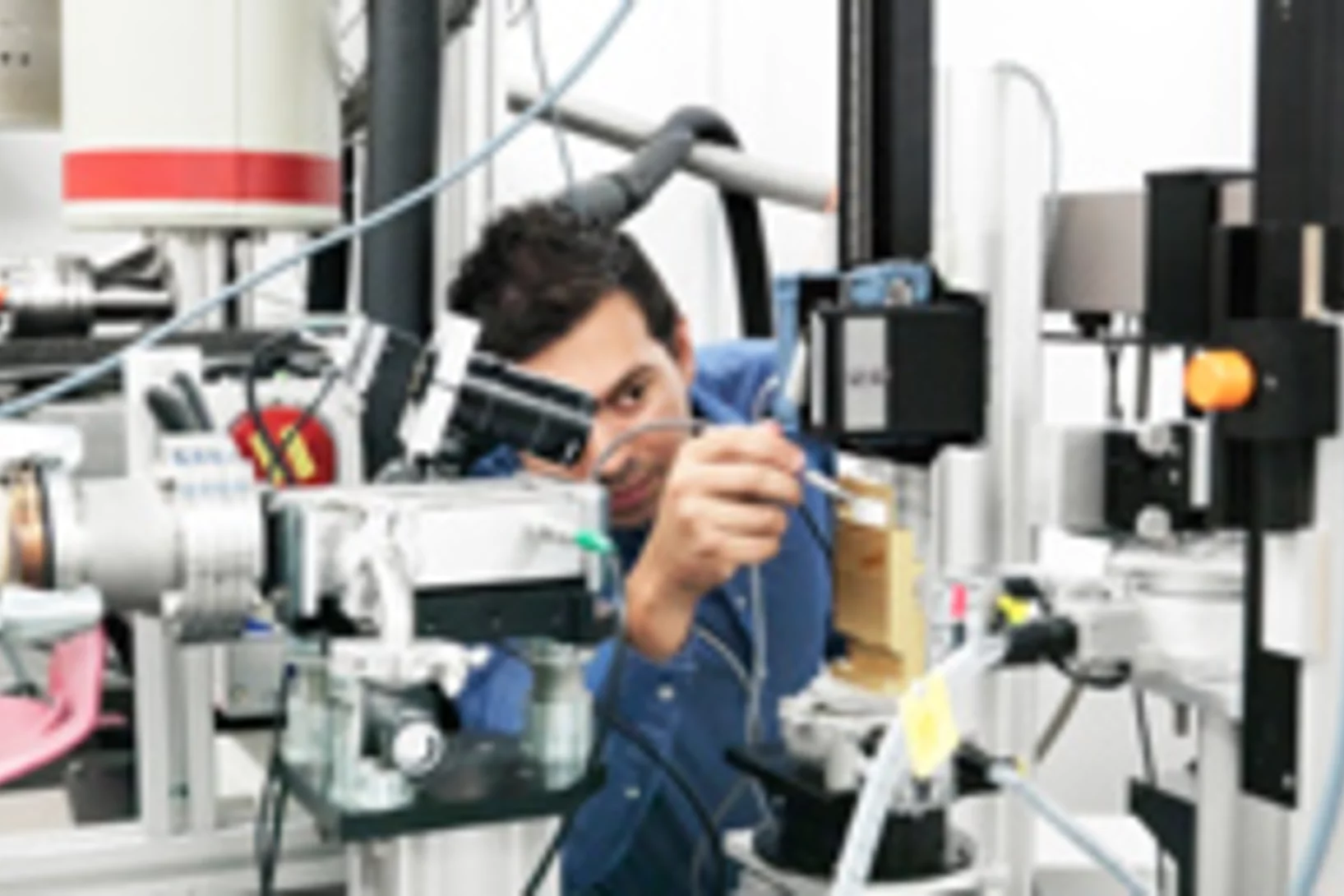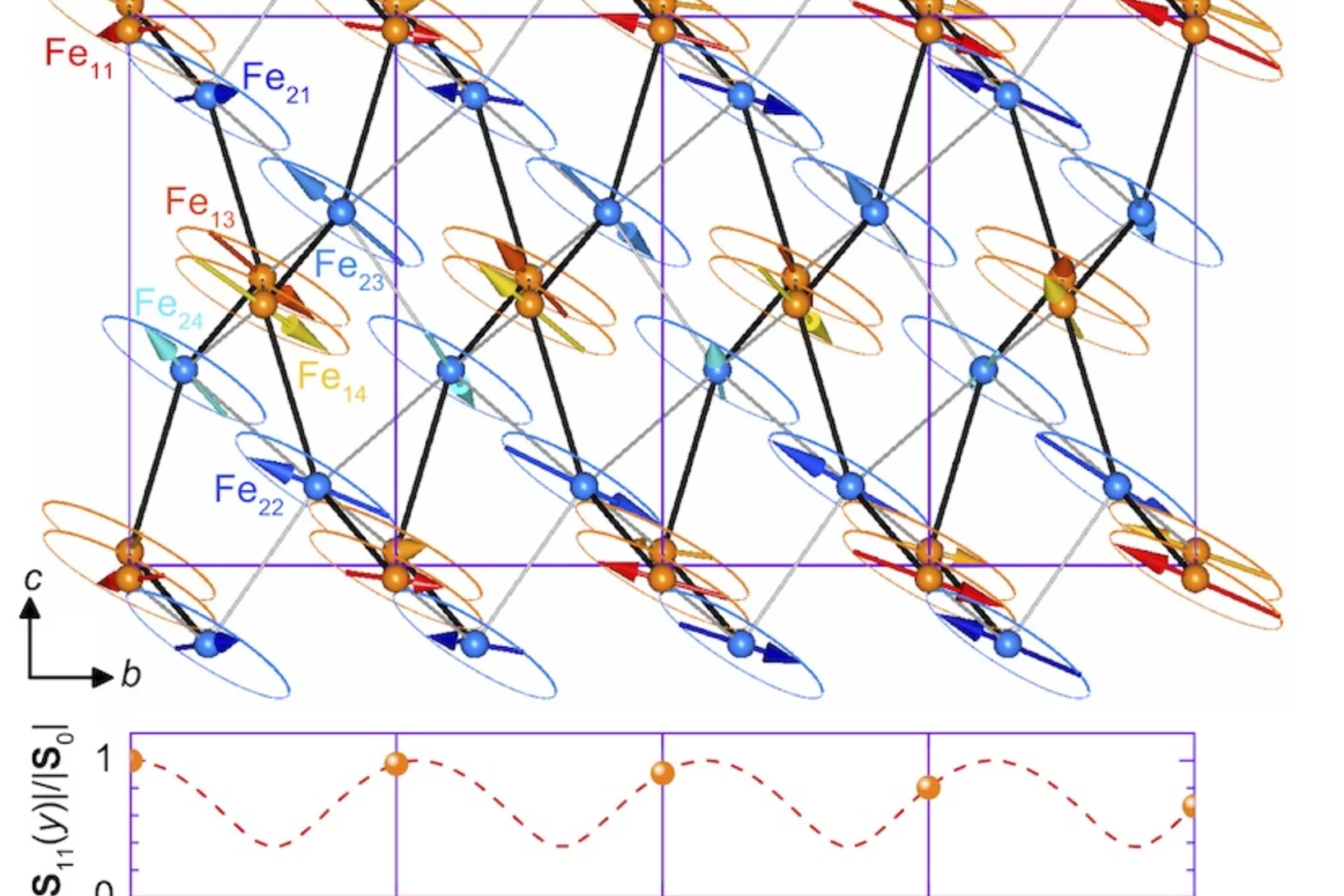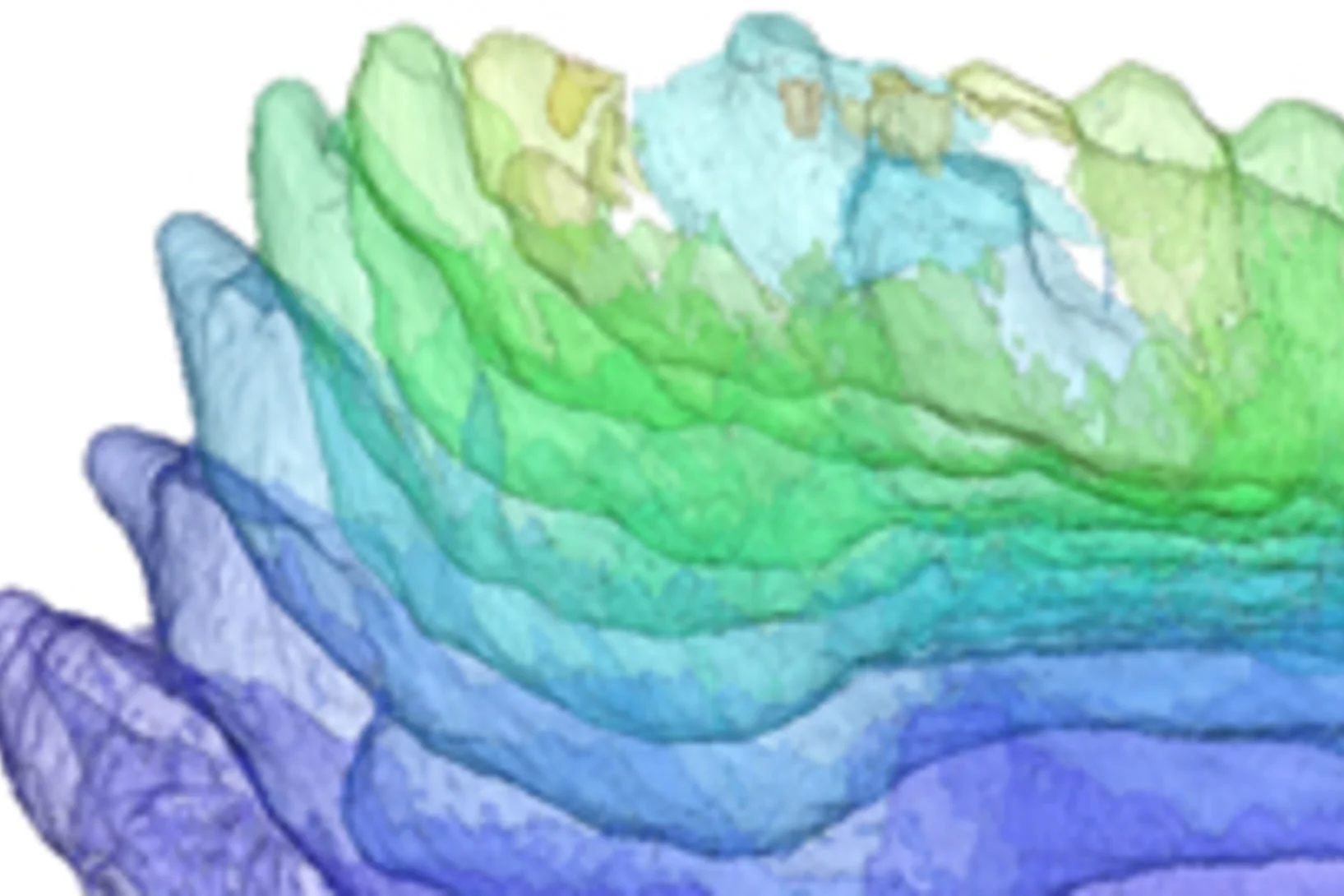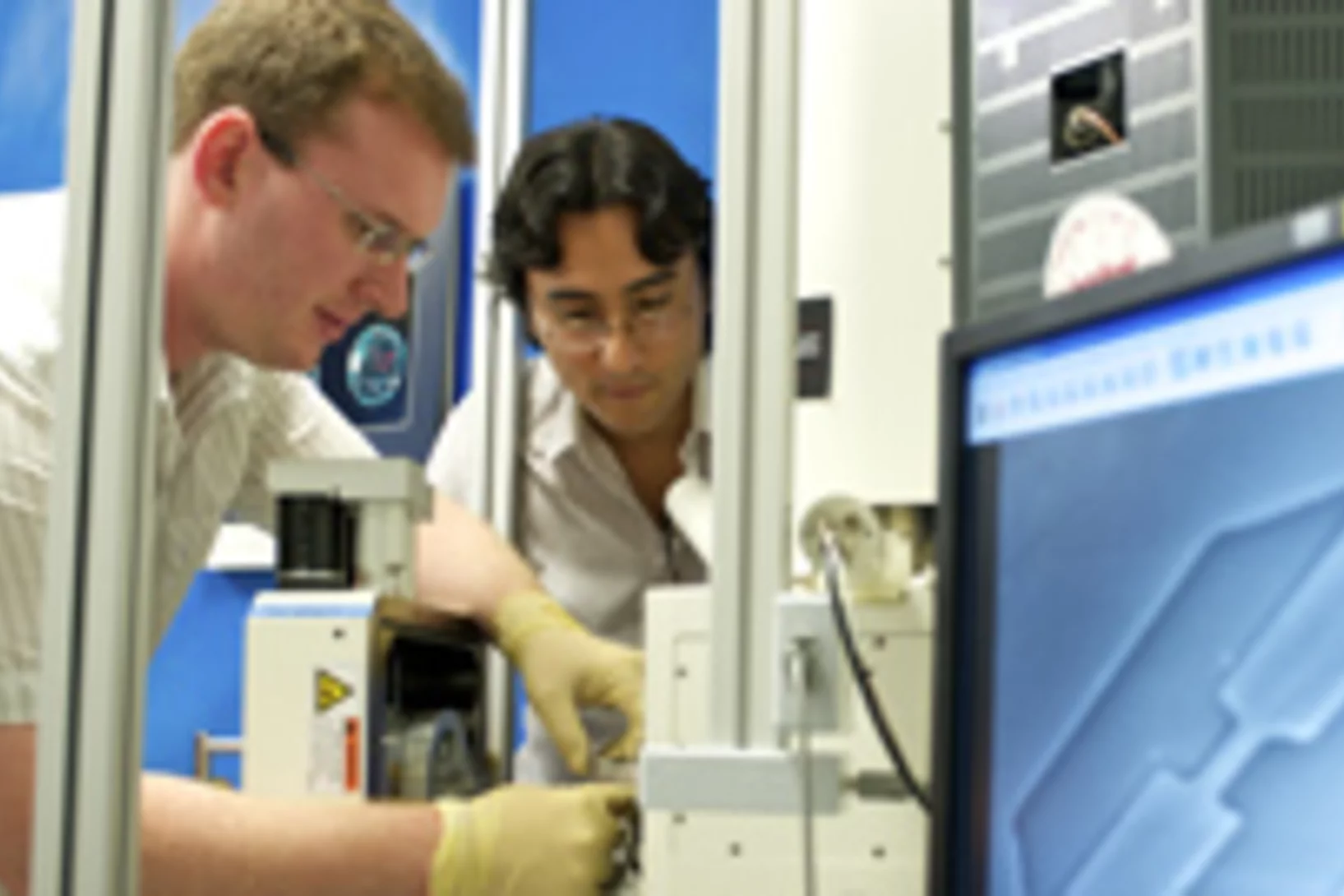Am PSI widmen sich mehrere Projekte wichtigen Forschungsfragen rund um das Coronavirus Sars-CoV-2 und den daraus resultierenden Erkrankungen. Wir informieren über Aktivitäten und Vorhaben, zum Beispiel zu Untersuchungen von Lungengewebe, zur Produktion von Proteinen und Antikörpern oder über Ideen für neue Forschung zu Covid-19.
Nützliche Links
Gebündeltes Bau-Knowhow für den SwissFEL
Mit der ARGE EquiFEL Suisse hat ein Konsortium aus drei Schweizer Traditionsunternehmungen den Zuschlag als Totalunternehmer für die Errichtung des Gebäudes und der Bereitstellung der technischen Infrastruktur für den SwissFEL erhalten. Gestern Abend fand die Unterzeichnung des Totalunternehmer-Werkvertrags zwischen dem Paul Scherrer Institut PSI und der Arbeitsgemeinschaft statt.
Fluktuationen mit Röntgenmikroskop sichtbar gemacht
Mit Röntgenstrahlen kann die Nanostruktur von so unterschiedlichen Objekten untersucht werden, wie einzelne Zellen oder magnetische Datenträger. Hochauflösende Bilder sind jedoch nur möglich, wenn sowohl Mikroskop als auch das Untersuchungsobjekt extrem stabil sind. Forscher der TU München des PSI zeigten nun, wie man diese Bedingungen lockern kann, ohne die Bildqualität zu beeinträchtigen. Auch hochdynamische Systeme, wie z.B. magnetische Fluktuationen, die die Lebensdauer von Daten auf Festplatten einschränken, können mit der neuen Methodik untersucht werden.
Chemistry: Ten things we need to know about ice and snow
Understanding the molecular behaviour of frozen water is essential for predicting the future of our planet, says Thorsten Bartels-Rausch.
Imaging fluctuations with X-ray microscopy
X-rays allow an inside look at structures that cannot be imaged using visible light. They are used to investigate nanoscale structures of objects as varied as single cells or magnetic storage media. Yet, high-resolution images impose extreme constraints on both the X ray microscope and the samples under investigation.
Magnetisches Nanoschachbrett baut sich von selbst zusammen
Forscher des Paul Scherrer Instituts und des Indian Institute of Science Education and Research haben in einer Anordnung magnetischer Moleküle gezielt den Magnetismus in jedem zweiten Molekül abschalten können, so dass ein magnetisches Schachbrettmuster entstand. Darin konnten die Forscher gezielt den Quantenzustand eines Teils der Moleküle manipulieren. Die Möglichkeit, die Zustände einzelner Quantenobjekte gezielt zu verändern, ist eine wichtige Voraussetzung für die Entwicklung von Quantencomputern.
SwissFEL – die Anlage
Im SwissFEL werden Elektronen auf beinahe Lichtgeschwindigkeit beschleunigt und dann auf eine Kurvenbahn geschickt - dabei erzeugen sie Röntgenlicht. Der SwissFEL besteht aus einer Elektronenkanone, die den Elektronenstrahl erzeugt, einem Beschleuniger und einem Undulator, in dem die Elektronen auf eine Wellenbahn gezwungen werden. Am Ende befinden sich die Messplätze, an denen das erzeugte Licht für Experimente genutzt wird.
Weiter Rätsel um das Proton
Ein internationales Forscherteam hat mittels Laserspektroskopie an exotischem Wasserstoff den unerwartet kleinen Wert für den Protonenradius bestätigt. Die Experimente wurden am PSI durchgeführt. Das PSI erzeugt als einziges Forschungszentrum weltweit ausreichend viele Myonen für die Herstellung der exotischen Wasserstoffatome aus Proton und Myon.
Feuer und Flamme
Gas- und Dampfkraftwerke (GuD-Kraftwerke), auch Kombikraftwerke genannt, gehören in vielen Ländern Europas zu den Optionen für eine sichere Energieversorgung. In der Energiestrategie 2050 des Bundes sind sie als möglicher Ersatz für die auslaufenden Kernkraftwerke genannt. Kombikraftwerke verwandeln Erdgas durch den kombinierten Einsatz von Gas- und Dampfturbinen mit einer sehr hohen Effizienz von 60 Prozent zu Strom. Zudem lassen sich diese Kraftwerke schnell hoch- und herunterfahren, sie eignen sich also bestens zum Auffangen von Produktionsschwankungen aus Wind- und Solarkraftwerken. Doch ihre CO2-Emissionen sind, wenn auch die tiefsten aller konventionellen Kraftwerke auf Basis fossiler Brennstoffe, immer noch beträchtlich. An einer Lösung arbeiten Forscher des Paul Scherrer Instituts im Rahmen eines europäischen Projektes.
The fabrication of small molecule organic light-emitting diode pixels by laser-induced forward transfer
Laser-induced forward transfer (LIFT) is a versatile organic light-emitting diode (OLED) pixel deposition process, but has hitherto been applied exclusively to polymeric materials. Here, a modified LIFT process has been used to fabricate small molecule Alq3 organic light-emitting diodes (SMOLEDs). Small molecule thin films are considerably more mechanically brittle than polymeric thin films, which posed significant challenges for LIFT of these materials.
Bereit zur Mondlandungsstimmung
Interview mit Thomas HuthwelkerDas Paul Scherrer Institut stellt Forschenden aus aller Welt seine Forschungsanlagen für ihre wissenschaftliche Arbeit zur Verfügung. Damit diese optimale Bedingungen antreffen treiben die PSI-Mitarbeitenden im Hintergrund beträchtlichen Aufwand. Ein Interview mit einem Forscher erlaubt einen Blick hinter die Kulissen. Das Interview stammt aus der neuesten Ausgabe des PSI-Magazins Fenster zur Forschung.
Magnetic nano-chessboard puts itself together
Researchers from the Paul Scherrer Institute and the Indian Institute of Science Education and Research (Pune, India) have managed to ‘turn off’ the magnetization of every second molecule in an array of magnetized molecules and thereby create a ‘magnetic chessboard’. The magnetic molecules were so constructed that they were able to find their places in the nano-chessboard by themselves.
Vorteile des SwissFEL: warum Röntgenlicht?
Der SwissFEL wird sehr kurze und sehr intensive Blitze aus Röntgenlicht mit Lasereigenschaften erzeugen. Mit Röntgenlicht kann man dank seiner sehr kurzen Wellenlänge sehr feine Strukturen sehen und so zum Beispiel die detaillierte Anordnung der Atome in einem komplexen Molekül bestimmen.
Partially reduced graphene oxide paper: a thin film electrode for electrochemical capacitors
One way to utilize graphene and its’ outstanding specific surface area of 2630 m2g-1 for supercapacitor electrodes is by preparing a so called free-standing graphene paper. Such a flexible, conductive graphene-paper electrode was prepared by a flow-directed filtration of graphene oxide dispersion followed by a gentle thermal reduction treatment of the filtrate. The prepared partially reduced graphene oxide paper (GOPpr) showed a dense packing of graphene sheets with a distinct interlayer distance of 4.35 Å.
Die Sonne geht auch für Zement auf
Zement hält die gebaute Welt zusammen. Das Bindemittel für Beton und andere Baustoffe ist, am globalen Produktionsvolumen gemessen, eines der weltweit wichtigsten Wirtschaftsgüter. Doch die Herstellung von Zement verbraucht enorme Mengen an Energie à und diese wird zum grossen Teil aus der Verbrennung fossiler Brennstoffe gewonnen. Forscher des Paul Scherrer Instituts und des weltweit tätigen Schweizer Zementherstellers Holcim wollen dies ändern. Mit konzentrierter Sonnenenergie soll aus kohlenstoffreichen Abfällen hochwertiger und klimaschonender Brennstoff für die Zementöfen der Zukunft erzeugt werden.
Spin ladders and quantum simulators for Tomonaga-Luttinger liquids
Magnetic insulators have proven to be usable as quantum simulators for itinerant interacting quantum systems. In particular the compound (C5H12N)2CuBr4 (for short: (Hpip)2CuBr4) was shown to be a remarkable realization of a Tomonaga-Luttinger liquid (TLL) and allowed us to quantitatively test the TLL theory.
Stoffen bei der Umwandlung zusehen
Experimente am SwissFEL sollen helfen, genau zu verstehen, wie sich Stoffe in einer Reaktion ineinander umwandeln. Ein Schwerpunkt werden katalytische Reaktionen sein, die zahllose Anwendungen haben. Die Forschung wird Wege zu energiesparenden Industrieprozessen und umweltfreundlichen Energieträgern aufzeigen.
Die schwache Seite des Protons
Ein internationales Forschungsteam hat mit grosser Genauigkeit bestimmt, wie das Proton an der schwachen Wechselwirkung à einer der vier fundamentalen Kräfte der Natur à teilhat. Die Ergebnisse bestätigen die theoretischen Voraussagen des Standardmodells der Teilchenphysik. In dem Experiment wurde beobachtet, mit welcher Wahrscheinlichkeit Myonen von Protonen eingefangen werden à ein Prozess, der von der schwachen Wechselwirkung bestimmt wird. Das Experiment wurde am Paul Scherrer Institut PSI durchgeführt, dem einzigen Ort weltweit, an dem genügend Myonen zur Verfügung stehen.
Wie stabilisierte Zellfasern Krebszellen am Teilen hindern
Die unter dem Schlagwort Chemotherapie verwendeten Krebsmedikamente hindern Zellen daran sich zu teilen. Da sich die Zellen in einem wachsenden Tumor häufiger teilen als andere, werden Tumorzellen besonders stark geschädigt. Forscher des Paul Scherrer Instituts und der ETH Zürich haben nun für eine Klasse solcher Medikamente den genauen Wirkmechanismus aufgeklärt. Die gewonnenen Informationen sind so exakt, dass man nun gezielt Medikamente entwickeln könnte, die noch besser an ihre Aufgabe angepasst sind.
Variations in diesel soot reactivity along the exhaust after-treatment system, based on the morphology and nanostructure of primary soot particles
The reactivity of soot at different sites of the exhaust after-treatment system of a diesel engine (upstream and downstream of the diesel oxidation catalyst (DOC), downstream of the diesel particulate filter (DPF), as well as inside the DPF) was investigated on the basis of morphology and structure of primary soot particles by high resolution transmission electron microscopy (HRTEM). The results indicate that combustion-formed soot particles are susceptible to further transformations of their morphology within the exhaust system.
Persistent Spin Dynamics Intrinsic to Amplitude-Modulated Long-Range Magnetic Order
In geometrically and/or exchange frustrated materials spin fluctuations may endure down to lowest accessible temperatures - the phenomenon known as persistent spin dynamics. Since spin fluctuations hinder the onset of extended static correlations, persistent spin dynamics and long-range magnetic order are generally considered as mutually exclusive. Remarkably, their coexistence has been found in several frustrated magnetic systems but was lacking a suitable explanation.
Die neue Schweizer Energiepolitik: Woher kommt der Strom?
Der neue Energie-Spiegel ist da.Mit der neuen Energiepolitik kommen grosse Veränderungen auf die Schweizer Stromversorgung zu. Werden erneuerbare Energiequellen genug Strom produzieren, um nach dem Aus der Kernkraftwerke unseren Verbrauch zu decken? Oder müssen wir uns in Zukunft auf Gaskraftwerke und Stromimporte verlassen? Und wie wirkt sich die neue Energiepolitik auf die CO2-Bilanz und die Stromkosten aus? Diese Fragen versucht die neueste Ausgabe des Energie-Spiegels zu beantworten.
Electric field control of the skyrmion lattice in Cu2OSeO3
Skyrmions are topologically protected magnetic spin 'whirls' that form a hexagonal 2D lattice in non-centrosymmetric magnets. Until recently, skyrmions had only been observed in itinerant metallic alloys such as MnSi, where they can also be manipulated by applied electric currents.
Der evolutionäre Ursprung unserer Zähne
Bislang war umstritten ob die frühesten Wirbeltiere, die Kiefer hatten, schon Zähne besassen oder nicht. Nun hat ein international zusammengesetztes Forschungsteam gezeigt, dass der urzeitliche Fisch Compagopiscis bereits Zähne hatte. Das deutet darauf hin, dass Zähne in der Evolution gemeinsam mit den Kiefern entstanden sind à oder zumindest kurz danach. Federführend bei dem Projekt waren Forscher der Universität Bristol (England), die entscheidenden Untersuchungen sind an der SLS durchgeführt worden.
X-rays provide insights into volcanic processes
Experiments performed at the Paul Scherrer Institute (PSI) investigate processes inside volcanic materials that determine whether a volcano will erupt violently or mildly.
Röntgenlicht liefert Einblicke in die Ursachen von Vulkanausbrüchen
Experimente am Paul Scherrer Institut bieten Einblicke in Vorgänge in vulkanischen Materialien, die darüber entscheiden wie heftig ein Vulkan ausbricht. Dabei haben Forschende ein Stück vulkanisches Material so aufgeheizt, dass darin Bedingungen entstanden, wie sie am Beginn eines Vulkanausbruchs herrschen. Sie nutzten dann Röntgenlicht aus der SLS, um in Echtzeit zu verfolgen, was in dem Gestein passiert, während es schmilzt.
Nobelpreiswürdig: G-Protein-gekoppelte Rezeptoren
Der Nobelpreis für Chemie geht in diesem Jahr an Robert J. Lefkowitz und Brian K. Kobilka. Sie haben herausgefunden, wie eine Familie von Rezeptoren funktioniert, die man G-Protein-gekoppelte Rezeptoren (GPCR) nennt. Auch am PSI leisten Wissenschaftler Beiträge auf diesem Forschungsgebiet.
Silizium – fast zum Zerreissen verspannt
Zieht man ein Stück Silizium auseinander, erzeugt man in dessen Inneren eine mechanische Spannung, die die elektronischen Eigenschaften des Materials deutlich verbessern kann. Forscher des Paul Scherrer Instituts und der ETH Zürich haben mit einem neuen Verfahren in einer Siliziumschicht extrem verspannte Nanodrähte erzeugt. Für ein Material, das als Grundlage für Elektronikbauteile dienen kann, wurde dabei die bislang höchste mechanische Spannung gemessen. Ziel ist es, auf Basis solcher Drähte leistungsfähige Transistoren für Mikroprozessoren herzustellen.
Eingebaute Germanium-Laser könnten Computer-Chips schneller machen
Forscher des Paul Scherrer Instituts haben untersucht, wie man das Halbleitermaterial Germanium dazu bringen könnte, Laserlicht auszusenden. Als Lasermaterial könnte Germanium mit Silizium die Grundlage für neuartige Computerchips bilden, in denen Informationen zum Teil in Form von Licht übertragen würden. Diese Technologie würde es ermöglichen, den Datenfluss auf Chips zu revolutionieren und so die Leistung der Elektronik weiter voranzutreiben.
Neue Einblicke in Supraleitermaterialien
Eine neue Röntgenmethode erlaubt Einblicke in die magnetischen Eigenschaften einzelner Atomlagen eines Materials, das die Grundlage einiger Hochtemperatursupraleiter bildet. Dabei zeigte sich, dass sich die atomar dünnen Materialschichten in den magnetischen Eigenschaften erstaunlich wenig von makroskopisch dicken Materialproben unterscheiden. In Zukunft könnte man so Vorgänge in sehr dünnen Supraleitermaterialien erforschen und zum Verständnis des Phänomens der Hochtemperatursupraleitung beitragen.
Erschliessungsarbeiten für den SwissFEL starten
Am 3. September 2012 starten die Erschliessungsarbeiten zur neuen Grossforschungsanlage SwissFEL des Paul Scherrer Instituts. Mit ihnen wird die für den SwissFEL notwendige Anbindung an die vorhandene PSI-Infrastruktur hergestellt.











